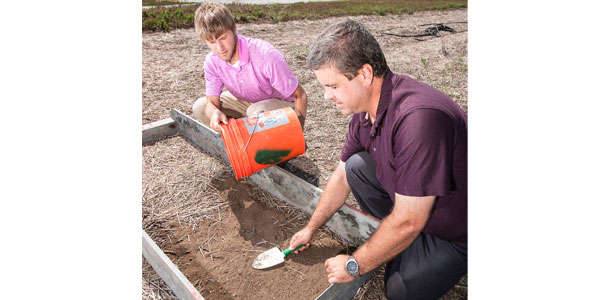“Manure makes a great fertilizer because it has so many nutrients,” agrees ARS agricultural engineer Bryan Woodbury. “But more people are moving to rural areas and don’t like the odor, so we’re trying to find a way to help producers control odors more effectively.”
Wherever manure ends up, its decomposition releases volatile fatty acids, aromatics, sulfides, amides and alcohols that are responsible for the odors. There has been some research on reducing odors when manure is used for fertilizer, but much of the work has been focused on applications of swine manure and poultry litter, which can be very different than beef manure applications.
Another factor that affects beef manure odor emissions is diet. Some producers supplement livestock feed with wet distillers grains with solubles (WDGS), a coproduct of corn ethanol production. Adding WDGS to cattle feed can increase the dietary levels of phosphorus, nitrogen and sulfur, which in turn can raise emissions of ammonia and other odor-causing compounds.
However, WDGS feed supplements are a cost-effective way for livestock producers to lower their expenses, so producers are interested in finding approaches to managing manure odors that do not limit their use. One alternative is identifying how different beef manure application methods affect the emission of odor-causing compounds.
Woodbury and Gilley decided to conduct a comprehensive study to identify compounds responsible for beef manure odor and to evaluate how diet, soil moisture and application procedures affect odor emissions. Woodbury works in the ARS Nutrition and Environmental Management Research Unit in Clay Center, Nebraska, while Gilley works in the ARS Agroecosystem Management Research Unit in Lincoln, Nebraska.
ARS agricultural engineer Roger Eigenberg and microbiologist Daniel Miller also collaborated on the study, as did West Texas A&M University professor David Parker and University of Nebraska – Lincoln professor David Marx.
“Compounds that cause odor are really hard to identify, so we knew we had our work cut out for us,” Gilley says.

From the feedlot to the field
In their study, the team used manure collected from feedlot pens where cattle consumed diets containing 0, 10 or 30 percent WDGS. The scientists also evaluated two application methods – no-till surface manure application and disk tillage that incorporated manure into the soil – and collected air samples before and after water was added to the soil to assess the effect of moisture levels on emissions.
Beef cattle manure was applied at levels that provided 135 pounds of nitrogen per acre, which met the one-year nitrogen requirement for corn. This meant that some plots received more manure than other plots because varying levels of WDGS in the cattle feed resulted in different levels of nitrogen in the manure. This approach was selected so that study findings related to odor mitigation practices would have more real-world relevance for producers.
After collecting and analyzing the air samples, the researchers determined that two volatile fatty acids – isovaleric acid and butyric acid – and the aromatic compound 4-methylphenol were responsible for more than two-thirds of detectable beef manure odors. Most of these odors were released within 24 hours after manure was applied to the soil.
Incorporating the manure into the soil and irrigating afterwards reduced most of the odor compounds that were measured. But the manure needed to be incorporated almost immediately after it was applied to obtain the most effective odor mitigation.
The importance of tilling manure into soil was highlighted by emission measurements the researchers obtained for 4-methylphenol. The greatest emissions of this compound occurred from dry soils on no-till plots and were sometimes as much as 10 times more than similar emissions from tilled soils.
The researchers also noted some significant differences between emissions produced by volatile fatty acids and aromatics and emissions produced by sulfide compounds. These differences were especially notable in soils amended with manure produced by cattle that consumed feed with 30 percent WDGS. This type of manure emitted two sulfide compounds (dimethyl disulfide and dimethyl trisulfide) at significantly higher levels than other manures in the study – sometimes as much as eight times more.
The researchers also saw something they didn’t expect to see: Overall emissions of the sulfide compounds increased when soil moisture levels increased, unlike the other odor compounds, where emissions decreased as soil moisture levels increased. They are currently conducting additional laboratory studies to determine why this occurred.
“It was a big surprise to us,” Woodbury says.
“Our results basically confirm that producers who want to use beef manure to improve soil quality can incorporate it into the soil to reduce odors and maintain nutrients,” Woodbury says. “Now we’re working on ways to manage manure in the feedlot that will improve its characteristics as a soil amendment.”
“Knowing the principal components that influence odors in feedlots – pen location, moisture and temperature –will help us with these investigations,” Gilley adds.
This research, which was published in the Journal of Environmental Quality in 2013, was conducted as part of the GRACEnet (Greenhouse-Gas Reduction through Agricultural Carbon Enhancement Network) program. GRACEnet is an effort to coordinate research projects at multiple ARS locations and determine the effects of management practices on soil carbon sequestration, trace gas emissions and environmental quality. ![]()
Ann Perry is part of the ARS information staff. This article originally appeared on the USDA-ARS website
PHOTOS
TOP: Agricultural engineer Bryan Woodbury (front left) collects a soil sample to characterize soil conditions following the field application of beef manure while agricultural engineer John Gilley (front right) and biological sciences aides Seth Lamb (kneeling) and Charles Hinds (standing) adjust small wind tunnel equipment to be used for air quality measurements.
BOTTOM: Biological sciences aide Charles Hinds (left) and microbiologist Daniel Miller apply beef cattle manure to experimental plots in studies to identify compounds responsible for manure odor. Photos provided by the USDA-ARS.








